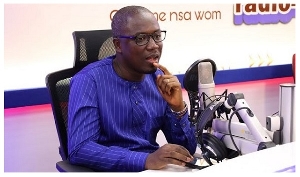- Home - News
- TWI News | TV
- Polls
- Year In Review
- News Archive
- Crime & Punishment
- Politics
- Regional
- Editorial
- Health
- Ghanaians Abroad
- Tabloid
- Africa
- Religion
- Election 2020
- Coronavirus
- News Videos | TV
- Photo Archives
- News Headlines
- Press Release
Opinions of Saturday, 2 July 2011
Columnist: Yeboah, Kwame
Koobi And Cell Phones “Can Cause” Brain Cancer?
An announcement last month from the International Agency for Research on Cancer of the World Health Organization (WHO/IARC) that they have classified radiofrequency (RF) electromagnetic fields, such as those from mobile/cell phones, as possibly cancer-causing in humans has garnered apprehension particularly in Africa where the use of cell phones is the highest in the world.
Despite modern era of information overdose and associated abuse, there are some organizations that, in the minds of public health professionals in particular and the general public in general, have an aura of authenticity. The World Health Organization (WHO) is one such organization. When the WHO comes up with a report that associates cancer to mobile phone usage, there is bound to be worldwide excitement. And for good reason. There is an estimated five billion mobile phone connections around the world. If mobile phones do indeed cause cancer, it is something to be actually worried about.
But what did the IARC actually say and what does it mean?
It was reported that 31 scientists from 14 countries met in Lyon, France, to pore over hundreds of previous scientific articles to assess the potential carcinogenic hazards from exposure to radiofrequency electromagnetic fields. The IARC Monograph Working Group, as the researchers are called, discussed and evaluated the available literature and concluded that the data was inadequate to draw conclusions for cancers other than glioma, a rare malignant type of brain cancer that strikes three to five people per 100,000 in population. For gliomas, however, the scientists found some evidence, though limited of carcinogenicity, meaning that a positive association between mobile phone use and cancer had been found, but that chance and bias could not be ruled out for this connection. The scientists did not specify the level of risk, but one previous study of mobile phone use showed a 40% increased risk for gliomas in the highest category of heavy mobile phone users (which was classified as 30 minutes per day of use over a 10-year period). The scientists found these results to be compelling enough to give radiofrequency electromagnetic fields a 2B classification as an agent that might cause cancer.
To better understand the issue let’s take a look at the classification. The IARC Monographs scale is as follows: Group 1: Carcinogenic to humans; Group 2A: Probably carcinogenic to humans; Group 2B: Possibly carcinogenic to humans; Group 3: Not classifiable as to its carcinogenicity to humans; Group 4: Probably not carcinogenic to humans.
The radiofrequency electromagnetic radiation falls into category 2B, the same category as such innocuous potential cancer-causing agents such as coffee, talcum powder, naphthalene, dry cleaning and pickled vegetables. But also in the 2B category are more threatening agents such as DDT and gasoline (diesel, petrol and probably Kerosene), and its fumes.
Pickling causes cancer? Pickling, also known as brining or corning is the process of preserving food by fermentation in brine (a solution of salt in water) to produce lactic acid or marinating, and storing it in an acid solution, usually vinegar (acetic acid). The resulting food is called a pickle. This procedure gives the food a salty or sour taste.
Fellow, Ghanaians and Africans, did you read the above paragraph well and do you now get what I am driving at? Pickling is the method we use to prepare Koobi, Kako, one-man thousand, Osamini, Momone, Kosohwe, etc., etc. Secondly, in my village, everybody, from the new born child to grandmothers bathed themselves in talcum powder after every bath, which occurs every day. Maame Nkra (the Accra lady) who supplied my mother with these items was a favorite visitor to our house.
Your Lord/Ladyships of Africa, before, you start insulting me with all those invectives about Koobi and cancer or before you start saying “Oh dear, something else to worry about”, please I want to assure you that you are not alone. I am with you. When I saw the items listed in group 2B, I called my family in Otwereso and Ayirebi to ask them to go for check up. My uncle pleaded with me to go to the hospital to see a Psychiatric to check my head or to come home. It looks like I have been away for too long, it is affected my brains.
I am not done yet. Of the 32 things beginning with the letter C including cell phones that are possibly carcinogenic to humans, include coffee, carpentry, coconut oil in shampoo and carrageen, a thickener found in instant-pudding mixes. In Ghana, pudding includes, rice water, banku, Ga kome, kooko, kose, cake, akple’, achaka, and kpekple’. Hey, I am just the messenger so save your insult for the scientists. But you’ll be happy to know that living in Chorkor, or Chiana Paga are not on the list, yet. I did not also find Courts and Choo lorry on the list. The Ghanaian courts are not on the list probably because they are only carcinogen to the NDC government. I leave this part to the experts in food.
So is mobile phone use and all these other items innocuous or threatening? The word in the classification "possibly" can go either way. It is like the classic example of the half-filled glass; you see what you want to see. The 2B category is used when there is limited (or inadequate) evidence of carcinogenicity in humans and sufficient (or less than sufficient) evidence of carcinogenicity in experimental animals. This essentially means that while it can be concluded that such items can cause cancer in animals used to conduct the experiments, nothing can be conclusively said about the effect on humans.
“Given the potential consequences for public health of this classification and findings, it is important that additional research be conducted into the long-term, heavy use of mobile phones,” says IARC director Christopher Wild. “Pending the availability of such information, it is important to take pragmatic measures to reduce exposure such as hands-free devices or texting.” Translation: we don’t know if mobile phone use causes cancer, but there's certainly a compelling case to go hands-free when possible.
What is in this for Africa? Many more people in Africa use mobile phones than in any part of the world, a new report by the International Telecommunications Union has said. By the end of 2008, Africa had 246 million mobile subscriptions and over the past five years the continent's mobile phone use has increased at an annual rate of 65 percent - twice the global average, whiles mobile penetration has risen from just five percent in 2003 to well over 30 percent.
Cell phones have become the only practical way to connect to friends, family, and business associates. On a continent where bad roads, seasonal flooding that washes away bridges, poor transportation systems, rolling blackouts, undrinkable water, and fetid mounds of refuse remain the stuff of everyday existence, wireless telecommunications services stand out as a rare, perhaps unique, technological success story. Tens of millions of ordinary Africans carry cell phones today, something not even the richest of them could have possessed barely a decade ago. And every month, millions more dial in to the 21st century, with profound implications for African economies and societies. Mbarika and Mbarika quote the United Nations as reporting that sub-Saharan Africa – with 34 of the 50 poorest countries on Earth is the world’s fastest-growing wireless market.
Africa is going wireless for a very simple reason: The United Nation reports that in most sub-Saharan countries not even 1 percent of the population have landline-connected telephones. That compares with more than 10 lines per 100 people in Latin America and more than 64 per 100 in the United States. Even Mongolians have twice as many land lines per person than us. Indeed, Tokyo and New York City each have more fixed-line telephones than the whole of sub-Saharan Africa. These numbers are even more daunting when you consider that fixed lines tend to be concentrated in capital cities, leaving rural communities totally bereft. Also, fixed lines are difficult to operate and can take years to install even if thieves will not cut the copper wires and tend them to rings, chains and other ornaments, whiles you only need to buy a handset and prepaid cell phone calling card to get a wireless line. In addition, companies can erect base stations that cover a radius of many kilometers for much less than it would cost to run the copper cables from central exchange to every customer’s phone. This has made cell phone usage affordable for a large segment of the population. As a result, growing numbers of Africans at the top, middle, and even bottom rungs of the economic ladder depend on the wireless sector for their empowerment and livelihoods. I have not seen any people who take so much delight in owning cell phones, and handsets have become the preferred articles of gift in rural Ghana. As a result, Africans are buying mobile phones at a world record rate, and research shows that the take-up soared by 550% in the last five years.
But more than just inadequate landline networks and institutions are fueling Africa's wireless boom. Growing political stability has helped to attract foreign investors to the region. Africa and particularly Ghana has seen economic booms before – from cocoa, timber, gold and recently, oil – but hardly any have benefited the ordinary man. Cell phones may be different. On my recent visit to Ghana, I found out that the telecommunications sector is becoming the fastest-growing employer. It directly employs thousands of people and hundreds and thousands more, indirectly. While carriers provide jobs to qualified engineers and administrators, indirect employment has helped spread the wealth even to those who don't have the benefit of education or the right connections by offering them the opportunity to sell calling cards. In some cases, card vendors make more money than government secretaries and elementary school teachers. Overseas calls made from a wireless phone have become cheaper, which has let many people and businesses connect to relatives and foreign partners at much cheaper international calling rates than those charged on landlines.
Indeed, it has been shown that adding an additional ten mobile phones per 100 people boosts a typical developing country’s GDP growth by 0.6 percent. A large part of this boost comes from innovative use of mobile phone technology by local entrepreneurs. In contrast to their use in the developed world, mobile phones in Africa are used for a wide variety of tasks, from sending money to family members to buying a fish from the market. Many business men, farmers, and laborers are finding new uses for a tool thought of as simply a voice communication device in the West, and are coming up with original methods for solving their own problems. For example, contract laborers can now provide their phone numbers to potential employers and move on, instead of having to wait for hours at a workplace in case a job arises. Access to market information through mobile phones also provides rural communities with invaluable information about centers of business; many African fishermen check the local fish market prices on their phones to determine where to bring the day’s catch. In Ghana, farmers in Tamale are able to send a text messages to learn corn and tomato prices in Accra, over 1,000 kilometers away.
In light of the many advantages of the use of cell phones and the newly postulated potential for its harmful effect, what do we do? Below are few recommendations for the safe use of cell phones.
Let's start by talking about the type of radiation produced by cell phones. It isn't the same kind you'd experience if you entered the red zone at a nuclear power plant. Cell phones expose you to non-ionizing radiation -- that's the same sort of radiation produced by a microwave oven. It’s created by radio frequencies that cause -- again like that microwave oven -- heating. There's no argument, even from skeptics, that the frequencies and transmitted power from your phone produce some heating. And since you're holding the thing against your head you're exposing your brain to cell phone radiation. None of that is in dispute. It’s the link to cancer that is in question.
So short of lining your head with aluminum foil, what do you do to decrease any possible risks? I'll try to list ways you can do to help yourself in an order based on how easy each is to follow.
First try to shorten your cell phone conversations. The ladies, if you want to gossip, go to your friend or use testing instead of calling or use the speaker phone. The longer you hold the cell against your head the more exposure you receive. Since phones emit radiation when sending messages and not when it is receiving, you can try to talk less and listen more (tell this to the Ghanaian women led by the 31st December Women’s Movement). The next tip is just as easy to follow as the first. Move your phone from one ear to the other every few moments while you’re talking. That way you avoid concentrating all the radiation in one spot.
You need to know a bit about how cell phones work to understand why my next tip makes sense. The phone is a transceiver - - a receiver and transmitter housed in one tiny device. It links to a nearby cell tower where your signal is amplified and sent on to other towers -- that's why you get so much range from a low-powered cell phone. You may already know that. But here's what you might not know. If you're a good distance from a cell tower, or if the signal is weak for some other reason, the phone automatically boosts its transmitting power. That means, when the bars that display signal strength show a weak signal, your phone is cranking up the power and giving you a higher dose of non-ionizing radiation. So -- when you are in an area with low signal strength, avoid using your phone if you can. Wait until you’re in an area that offers a stronger signal, more bars.
Some people have suggested using a wired headphone and clipping the phone to your belt. Well, that's a good idea but not a perfect one. For one thing, you're moving the phone toward another vulnerable area -- your groin (and to the men, your balls. What is the point in calling the lady when your balls are cooking?).
So far, no quantification of the possible risks from cell phone use has been made, but groups like Cancer Research UK have recommended that children under 16, whose brains and central nervous systems are still developing, only use cell phones for essential calls. For Ghanaians, this would be a tough call, given the popularity of cell phones among the very young, from as early as primary school age, and teenagers.
While it is always good to be cautious, the mobile phone and cancer connection should still be treated as a hypothesis. SO DON’T HANG YET. CALL ME IF YOU CAN.
Kwame Yeboah
Harding University College of Pharmacy
Searcy, Arkansas. USA
gyeboah@harding.edu










